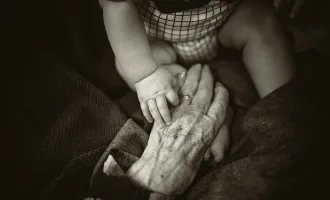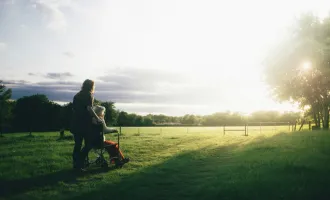
Aging and the Carbon Imaginary
Consider aging as three overlapping progressions: the accumulation of risk, aging as deterioration, and aging as renewal. Aging disrupts life/non-life distinctions, what Povinelli calls geontology, in that aging is a property of non-living matter, but which extends to living matter through consciousness, perception, dependence, and through diffraction into differing scales of time.
Our human lives are inextricably tied to the survival and coexistence of that of other species, living (plants, animals, fungi) and non-living (chemicals, landscapes, ecologies), whose existence may find itself on time-scales different than our own. Following aging as an analytic then allows for an analysis of carbon assemblages, and of our world’s rapidly changing climate and conditions of habitability.
(I refer to carbon assemblages as the symbolic analog to the Carbon Imaginary, as indicative of the centrality of oil to everyday life, and oil’s presence as the lifeblood of everything, from civil freedoms and political liberties to food and mobility. Oil is a commodity, and so it has particular properties and values it represents. In particular, the driving logics of non-renewable carbon assemblages emit a Malthusian signal, affecting the national and trans-national interests of markets of oil.)
The political and economic consequences of contemporary carbon assemblages can then be elucidated by following the ways their reproduction. In this essay, I argue that the persistence of the Carbon Imaginary actually relies on the accumulation of risk.
(I refer to the Carbon Imaginary here both in consideration of Povinelli’s definition in Geontologies, and of Lacan’s registers of experience. Povinelli describes the Carbon Imaginary as a being built from the break between Nonlife and Life, a problem of how something (life) emerges (lives, grows, dies) from nothing (nonlife) and returns to nothingness.
For Povinelli, life then becomes a sort of skin which we experience (as life, separating us from non-life.) For Lacan, the registers of experience: the real, imaginary, and symbolic, are indicative of the ways in which humans can observe and understand life (Lacan 1949).
The real is primordial or unchangeable truth; it is something that the psyche seeks to avoid encounter with, because it is distressing and often irreconcilable with existing perceptions of self. One version of the real, I speculate, would be for oil resources to run out. The real lies in contrast to the imaginary order, whose basis is in the formation of the ego in the mirror stage.
The real is thus an empty space, an alienation that is created by rupture; the real is a gap, which disrupts identification. Upon experiencing excitation or distress – an encounter with the real – individuals utilize narrativization to render their experiences into the symbolic and imaginary registers.
This allows reconciliation between the self, and the newly formed (or reformed; really, continuously forming) imaginary. Thus, we may consider aging, as the process of disruption and change, to be distressing because it encroaches upon ones’ sense of continuity of self and world. I argue that, to resist aging, including through the enactment of suspension, is an extension of the instinct to preserve the self, and to avoid death.
Given that climate change is inherent to the goals of colonialism (rendering of land, relation, and time as resources), this essay focuses on the Carbon Imaginary in order to situate itself in contemporary conversations that seek to center the importance of decolonial thought, and of unsettling as a methodology of anti-colonial resistance.
Writing from Povinelli’s conception of the analytic of geontopower as a diagnostic, this essay follows aging as part of a broader conversation that seeks to disquiet the contemporary conditions upon which human survival and survivance is contingent.
As part of this method of unsettling, this essay de-centers the human through a focus on the aging of more-than-human others. Late liberalism is contingent on the Carbon Imaginary, and on the survivability of the planet’s conditions.
(I consider Povinelli’s image of the scar – as a pulsing and aching region between Nonlife and Life. Scarring is the result of suspension – when time is not allowed to pass, when healing is not allowed to take place, and when natural metabolic processes are disrupted. For Povinelli, the Carbon Imaginary is a scar that has remained numb and dormant, but not unfelt. It is a scarred meeting place that is dominated by the desire for Life.)
Aging is a privilege. Survival is a privilege. The longer one lives, the more likely they are to lose their autonomy: to age is to accumulate risk. Seniors are differentially exposed to violence, abuse, and neglect on lines of race, class, gender, and sexuality.
(Elders are more likely to fall into elder homes where they are neglected and subjected to unhabitable living conditions, a part of the carceral archipelago, if they do not have close relationships to their families or communities, or otherwise the privilege of capital with which to ascertain caretakers. Such conditions are more commonly faced by queer and trans elders and who may be estranged from their biological kin, and who are already differentially exposed to risk factors that have historically rendered them less likely to have close kin.)
In a phenomenon that Cohen terms “the culling,” gerocidal logics have pervaded institutional responses to the COVID-19 pandemic that have prioritized productive work conditions and business-as-usual over human lives of vulnerable seniors. To age gracefully and in a state of continued well-being necessitates certain intentionality and community relations that may not always be available.
Human aging and survival, while unavoidable and grounded on unevenly distributed privileges, are inextricable from physical conditions. I follow the concept of the “accumulation of risk” from Watts, who writes about the oil assemblages and their centrality to the carbon imaginary.
In particular, Watts describes the 2010 Deepwater Horizon oil spill in Gulf of Mexico as an example the risk accrued by oil extraction manifesting as an offshore accumulation – an inevitable and destructive event of exceptional violence within which risk manifests in pollution and damage to local ecosystems.
The concept of “accumulation of risk” describes BP’s corporate culture, within which profits were prioritized over safety, and wherein risk taking and cost cutting – practices not unique to the offshore oil and gas industrial complex and related governance – leave deepwater oil vulnerable to damage from catastrophic evets such as hurricanes, and result in a cycle of further accumulation of biophysical risk, the “unrelenting accumulation of insecurity.”
(Aging as the accumulation of risk is different from aging as deterioration. Objects, whether living or Nonlife, degrade over time. In aging as accumulation of risk, humans attempt to impart the qualities of Life unto Nonlife by the enactment of suspension. Future risk is seen as favorable to current deterioration, and so technoscientific methods are used to create repair that allows for continued operation of non-living apparatuses like oil rigs.)
Key to oil apparatuses is the continued accumulation of risk over time, as the oil apparatuses themselves age and degrade. Given how oil is capacious, and is the infrastructure of much of present human life within late liberalism, the costs of human action are becoming clear in the continued rise of new environmental risks. “Oil”, Watts writes, “actively constitutes a particular ‘regime of living’ – but also, as I show, a regime of death, of bare life.”
The increasing proximity of all humans to death is accelerated by late liberalism’s colonial rendition of space and time as resources from which value is to be extracted.
The accumulation of risk is enacted by acts of suspension, or of putting off the imminence of deterioration towards a later date. Suspension can be thought of as a particular strategy of late liberalism: the intentional cultivation of indeterminacy as a way of holding off the consequences of extractive violence. The violence of aging as suspension is inevitable: deterioration can only be put off for an indeterminant amount of time.
Such suspension occurs through the normalization of past harms through processes of social and physical sedimentation, wherein inherited conditions, both cultural and environmental, are rendered invisible inheritances by the continued rupture caused by harm. Sedimentation, the compression of fossils into oil, can also be a transmutational force.
Hope may arise within suspension, but the continued sedimentation of risk through practices of extraction coalesces into a cycle of harm – a cyclical model of time within which there is a repetition of harm rather than a resolution or end.
Oil rigs’ destructive influence is the direct result of human action – oil companies draw on forms of scientific technological knowledge to suspend but not prevent environmental harm.
Considering this process through the lens of aging, requires considering the aging of people alongside the aging of oil rigs. Aging here is a shared process in that we are reliant on technoscientific ‘solutions’ that are entangled also with societal conditions, ecological shifts, and environmental inheritances. To make sense of these shared conditions, consider Povinelli’s
Karrabing analytics:
1. Things exist through an effort of mutual attention. This effort is not in the mind but in the activity of endurance.
2. Things are neither born nor die, though they can turn away from each other and change states.
3. In turning away from each other, entities withdraw care for each other. Thus the earth is not dying. But the earth may be turning away from certain forms of existence. In this way of thinking the Desert is not that in which life does not exist. A Desert is where a series of entities have withdrawn care for the kinds of entities humans are and thus has made humans into another form of existence: bone, mummy, ash, soil.
4. We must de-dramatize human life as we squarely take responsibility for what we are doing. This simultaneous de-dramatization and responsibilization may allow for opening new questions. Rather than Life and Nonlife, we will ask what formations we are keeping in existence or extinguishing?
The Karrabing analytics consider all things, Nonlife and Life, as the manifestation of attention. Deterioration, in this conception, is not the loss of energy or matter, but rather the changing of states: the turning away of attention to other modes of being.
Aging then is not the increasing proximity of death, but rather the transience of enduring attention. Being is a temporary state amidst the never-ending process of change.
Given the constant ending of worlds around us, in the form of mass-extinctions and desertification, consideration of Povinelli’s figure of the desert can further elucidate how narratives of uninhabitability are responses to settler-colonial modernization’s land use.
Damage, then, or deterioration, can be considered an acceleration of “entities withdrawing care for each other” or changing states. The increased rate of climate change is an increased rate of deterioration of attention.
Narratives of uninhabitability also result in a rise in the states of non-living matter. Viruses are one such agent of aging-as-deterioration, bordering life and continually transposing matter and attention from Life towards Nonlife.
“The new eternals” and “indecomposables,” are also a sign of such deterioration – technofossils whose intertness renders them embodiments of the human technoscientific intervention’s quest to create suspension. Though suspended and inert on human time-scales, such existences too will one day find themselves a part of matter’s cycle of breakdown. Endurance is only ever a temporary state.
Given the aging demographics of the human population, the need to understand aging is of growing necessity to the survival of our species. As the broken form of late liberalism comes into view, and culpability in carbon assemblages remains inextricable from our daily lives, understandings of aging must consider both humans and non-humans, living and non-living, to understand the changing states of our planet to which we bear witness.



